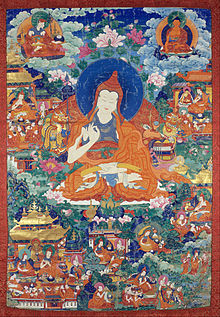Usuario:R. Vaporú/Taller
Apariencia
| Śāntarakṣita | ||
|---|---|---|
 | ||
| Información personal | ||
| Nacimiento |
724 d. C. Bengala | |
| Fallecimiento |
788 d. C. Tíbet | |
| Educación | ||
| Educación | Nalanda | |
| Información profesional | ||
| Ocupación | filósofo, bhikkhu y traductor | |
Śāntarakṣita (sánscrito: शान्तरक्षित, lit. 'protegido por el que está en paz')[1] fue un filósofo budista indio de la escuela madhyamaka sumamente influyente en la etapa temprana del budismo tibetano, siendo junto con Padmasambhava y su discípulo Kamalaśīla, uno de los primeros en llevar el budismo al Tíbet,[2] siendo el fundador y primer líder del Monasterio de Samye, el primer monasterio budista en la región.[3] Estudioso de Nāgārjuna,[4] discípulo de Jnanagharba, quien lo introdujo a la tradición yogachara,[5]y maestro de Kamalaśīla, junto con el cual logró llevar las enseñanzas budistas a los tibetanos.[6]
Obras
[editar]- Tattvasamgraha
- Madhyamakalamkara
- Tattvasiddhi
Referencias
[editar]- ↑ Śāntarakṣita's name might be understood as a poetic way of rendering "protected by the Buddha". Technically, like "Dharmarakṣita" or "Devadatta", the compound `Śānta-rakṣita' is to be understood as a `tṛtīyātatpuruṣa', or instrumental determinative compound, comprising the noun `Śānta-' ("peaceful [person]") in its (implicit) instrumental inflection on the one hand and the past passive participle `rakṣita' ("protected") on the other.
- ↑ «Śāntarakṣita - Stanford Encyclopedia of Philosophy». 3 de diciembre de 2008. «Śāntarakṣita (725–788) was one of the most important and pivotal thinkers in the history of Indian and Tibetan Buddhist philosophy.»
- ↑ «Santaraksita References». «Warmly greeted by king Trhisong Detsen, he began to construct Samye university- monastery».
- ↑ «Śāntarakṣita - Stanford Encyclopedia of Philosophy». 3 de diciembre de 2008. «His contributions to Buddhist thought were particularly noteworthy due to his historical position as one of the later Indian interpreters of the Madhyamaka thought of Nāgārjuna».
- ↑ «Santaraksita References». «His root teacher was Jnanagharba, whose philosophy was sometimes characterized as Yogacara Madhyamaka, which became Santaraksita's view.»
- ↑ «Śāntarakṣita - Stanford Encyclopedia of Philosophy». 3 de diciembre de 2008. «In affect, Śāntarakṣita (and later, his disciple Kamalaśīla) taught Tibetans how to do philosophy.»
